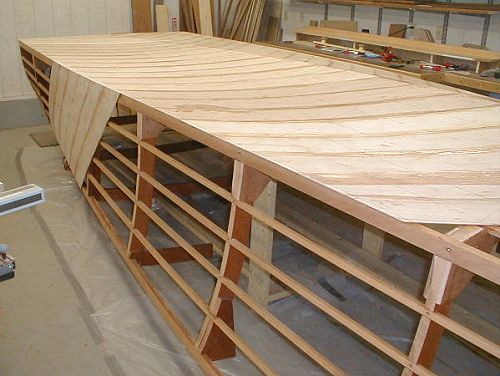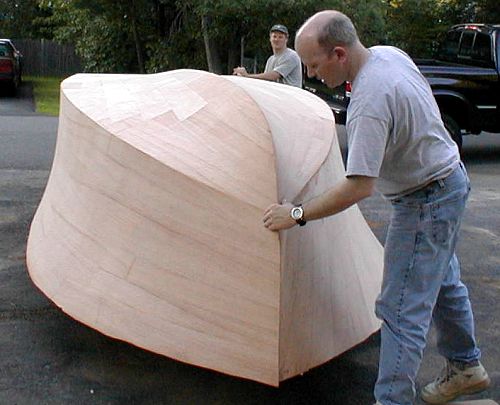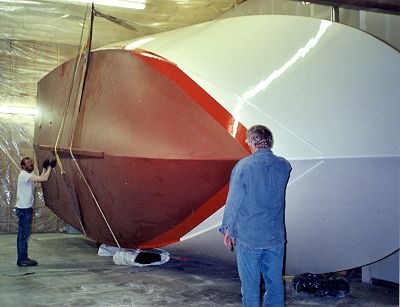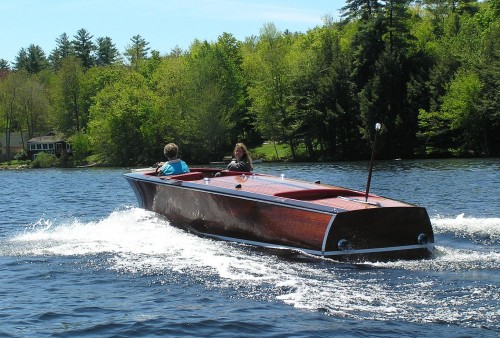Cold Molded Planking Review
Posted by Gayle Brantuk on Dec 15th 2010
Many of our boat designs call for cold molded, double or multiple diagonal planking. This is a method of applying the skin or planking of the boat in multiple layers; the first layer about 45 degrees and subsequent layers approximately crossing at right angles to the previous one. Cold Molding is used on boats that have compound curves that plywood will not conform to.
Bob Perkins applies first layer to Biscayne
Two layers shown on John Maddox's Biscayne
Veneers can be used however plywood, particularly when ¼” or thicker, is cheaper and easier to apply. Classic hulls, such as the mahogany runabouts, use solid wood planks run lengthwise over the laminates for a beautiful bright finish. Instead of this final wood plank veneer , the hull can be fiberglassed and painted.
The final layer is applied to the laminates of Bob's Biscayne
Final veneers on bottom & sides of Bob's Biscayne
Neil Quade's Sea Angler is a 35' painted cold mold hull
A width of 6” or so is often used for the diagonal strips however, the width is not critical. In the aft section of a typical runabout, the layers can be full or partial sheets of plywood when the area is relatively flat; it all depends on the hull contour. Sheet plywood won’t bend over compound curved surfaces so the laminates are narrowed in such areas.
How wide should the laminations be? Wide enough so the edges of the strips conform to the hull surface. The strips need not be the same width. As the surface curvature increases, the width can be reduced. There is no rule that states the strips must be uniform in width; in fact a somewhat “V” shape may be desirable.
Applying "v" shaped strips for cold molding
When the edge of a laminate tends to lift from the hull surface, or along the previous plank, the strips should be narrowed or tapered in width. Changing the angle of the laminate from the “approximate 45 degrees” may be advantageous. There will be a certain angle where the laminate will adhere to the hull surface without the edges curling to any degree; that’s the angle you seek.
Use a strip of the cold molded planking stock, 2”-3” wide bent over the hull to find the best angle to apply the next diagonal laminate; there will be a “sweet spot” where the laminate will mate solidly to the hull surface with minimal force. Change the angle again on subsequent planks if necessary.
When the edges of the planking don’t mate solidly it probably means the glue will not bond to the base properly; the structural integrity of the cold molding process depends on a positive glue bond of the layers. Eliminating curled edges of the diagonal laminates will also save a lot of grinding as the surface of each layer must be fair so subsequent laminates mate firmly and provide a positive glue bond.
Biscayne 22 by Bob Perkins--the results of a beautiful cold molded hull
In addition, the final surface must be smooth to receive the longitudinal planks or fiberglass covering. Spend a little more time checking and thinking and you can save a lot of work when applying cold molded planking. Come to think of it; isn’t that what boatbuilding is all about? Doing a lot of thinking before the actual doing pays off BIG! And doesn’t that apply to most phases of boatbuilding?






